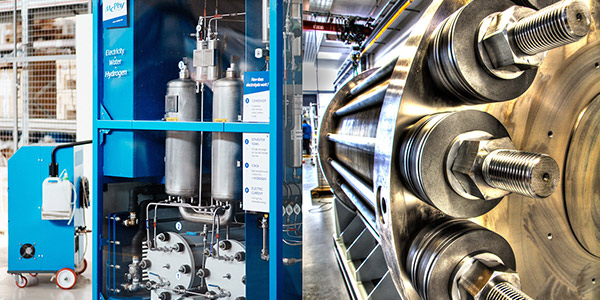The most abundant element in the universe could reduce greenhouse gas emissions and solve the problem of storing wind and solar energy if the cost of producing it comes down, advocates told NARUC’s Summer Policy Summit Tuesday.
Hydrogen is getting a lot of attention these days for its potential to store energy from intermittent resources and generate megawatts when the sun doesn’t shine or the wind doesn’t blow. But its cost remains prohibitively high.
The National Fuel Cell Research Center estimates that the expense of producing power from hydrogen fuel cells, now around $4,000/kW, needs to fall by more than 60% for it to become a competitive market player. (See Calif. Rushing Microgrids for Fire Season Shutoffs.)
Panelists said cost reduction is already underway.
Neva Espionza, generation director with the industry nonprofit Electric Power Research Institute, pointed to billions of dollars of investments in hydrogen technology in Western Europe, Saudi Arabia and Australia as developments that could spur less-expensive hydrogen production.
Kristine Wiley — director of the Hydrogen Technology Center at GTI, an Illinois-based research group founded by the natural gas industry — asked those listening to name the “top barrier to enabling the hydrogen economy.” More than half of those voting via cell phone app said “cost.” Wiley said GTI was using its well-funded research and development programs to bring costs down.

Advocates say solar-powered electrolyzers that produce hydrogen could help solve the West’s need for long-term storage of wind and solar energy. I McPhy Energy SA
Laura Nelson, executive director of the Green Hydrogen Coalition, assured listeners that costs are “falling fast” and will keep going down as production increases.
“From our perspective it’s not really a technology problem,” she said. “It’s a matter of scale and market design.”
“Green hydrogen is a super game changer,” Nelson continued. “We can attain a 100% renewable energy system that’s affordable, reliable and I would also say flexible and resilient.”
Methane Plus Hydrogen
To produce hydrogen without carbon emissions, excess wind and solar energy are used to power an electrolyzer that splits water molecules into hydrogen and oxygen. The electrolysis consumes large amounts of electricity, but the hydrogen can be stored for months — meaning ample summer solar power can make hydrogen for winter heating.
Hydrogen can also be used for storage in place of lithium-ion batteries, which currently have a maximum discharge time of about four hours. With lifespans of thousands of hours, hydrogen fuel cells can run indefinitely, important during extended outages.
Some industry advocates — including Tuesday’s panelists — are promoting a controversial plan to use green hydrogen as a partial substitute for natural gas, making use of existing gas pipelines and other infrastructure.
Nelson, who until recently served as energy advisor to the Utah governor’s office, said one big plan is already in the works.
The Intermountain Power Plant, a coal-fired facility in central Utah, is being repurposed to burn 30% green hydrogen combined with natural gas. The 1,800-MW plant, owned by the Intermountain Power Agency and operated by the Los Angeles Department of Power and Water, sends electricity to Southern California.
Nelson said the plant — which is scheduled to undergo a $500 million, years-long refit — is an ideal test case for combining methane and hydrogen.
“You have a big production capacity. You’ve got big offtake, and you’ve got all of the infrastructure to deliver a clean energy resource,” she said.
The plant is “strategically located near some salt formations,” where hydrogen can be stored in caverns large enough to hold the Empire State Building, with plenty of room to spare, Nelson said. There’s enough room near the power plant for 100 salt caverns.
Opponents have repeatedly argued, however, that mixing hydrogen with methane won’t help California achieve its goal of using zero-carbon energy by 2045 and will only extend the use of natural gas as a primary energy resource in the West. Owners of gas infrastructure are pushing the plans as a way to keep their assets from becoming “stranded” and worthless, they contend.
During the Q&A session, an unnamed participant questioned the planned ratio of hydrogen and methane at the Intermountain plant. (The written query was read aloud by Minnesota PUC Commissioner Valerie Means, who co-moderated the panel with fellow Minnesota Commissioner Matt Schuerger.)
Nelson responded that the mix would lower greenhouse gas emissions from the plant by up to 75% when it comes online by 2030 and that LADWP was hoping to eventually eliminate all GHGs.


